By David Yonke
Toledo Blade
April 21, 2006
http://toledoblade.com/apps/pbcs.dll/article?AID=/20060421/DEVELOPINGNEWS/60421009
Jurors in the murder trial of the Rev. Gerald Robinson were taken on a tour today of the Mercy Hospital chapel and sacristy where Sister Margaret Ann Pahl was strangled and stabbed in April, 1980.
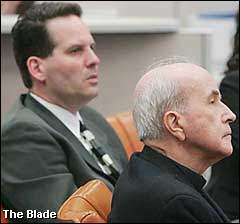 |
|
The Rev. Gerald Robinson and his attorney John Thebes listen to opening statements today in the priest's murder trial. Photo by The Blade/Allan Detrich |
After opening statements, the 12 jurors and four alternates were taken by bus to the former hospital, now a college, slightly more than a mile from the Lucas County Courthouse.
They were then led on a 40-minute tour of the buildings where the slaying occurred and where Father Robinson lived in a small apartment at the time.
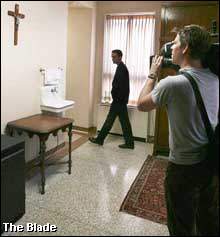 |
|
Prosecution assistant Brad Smith tours the hospital chapel sacristy where Sister Margaret Ann Pahl was killed in 1980, as Joe Hoffman videotapes. The jury visited the crime scene. Photo by The Blade/Allan Detrich |
A terse script that had been approved by attorneys for both sides was read by court bailiff Tanya Butler, pointing out certain locations and parts of the building to jurors, but not specifying their connection to the case.
For example, the jurors were directed through the sacristy next to the chapel but were not told that it was where Sister Margaret Ann's body was found. They also were told to note the size of two rooms at the end of a hall, but were not informed it was Father Robinson's living quarters in 1980.
During opening statements this morning, the prosecution told jurors that it will prove that a sword-shaped letter opener belonging to Father Robinson was used in the brutal murder of the nun the day before Easter, 1980.
Dean Mandros, assistant Lucas County prosecutor, said the unusual shape of the blade fit Sister Margaret Ann's wounds "like a key in a lock."
Mr. Mandros also said that the Toledo priest lied about his whereabouts on the morning of the murder and that he will produce witnesses who can place him at the chapel at the time of the slaying.
Defense attorney Alan Konop focused on the fact that the state's evidence is circumstantial and said there are inconsistencies and flaws in the prosecution's case that will raise reasonable doubts.
He said DNA tests of a foreign substance found on the nun's underwear did not match that of Father Robinson, and that separate tests of material found under the nun's fingernails contained a male chromosome which did not match the priest's.
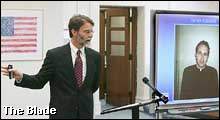 |
|
Assistant Lucas County Prosecutor Dean Mandross addresses the jury during opening statements today. Photo by The Blade/Allan Detrich |
Mr. Konop said Father Robinson, now 68, was subjected to "the humiliation and degradation" of an arrest before the state had enough evidence to prove its case, and that prosecutors were scouring for information and consulting new experts as recently as February.
The two sides spent a total of 45 minutes outlining their cases this morning in what is believed to be the first time in the United States that a Roman Catholic priest is charged in the murder of a Roman Catholic nun.
Mr. Mandros, in a thorough, matter-of-fact presentation of the state's case against the priest, said Sister Margaret Ann was choked with such force that the killer broke two bones in the side of the neck and broke blood vessels in her eyes.
The assailant then laid her on the floor of the sacristy, draped her body with an altar cloth, and stabbed her nine times in the heart in the shape of an upside down cross. He then stabbed her 22 more times, he said, and pulled her smock up and her undergarments down to leave her lying "naked and exposed" on the sacristy floor.
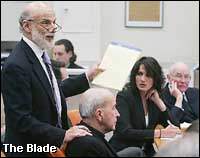 |
|
Defense attorney Alan Konop, left, during opening statements in Father Robinson's trial. Attorneys Nicole Khoury and Jack Callahan, at right. Photo by The Blade/Allan Detrich |
The trial resumes Monday morning with testimony from some of the 40 expert witnesses.
The Lucas County cold-case squad reopened the murder case in December, 2003, after another woman alleged she was the victim of ritual abuse as a child by a group that included several priests, including Father Robinson.
Investigators recalled that the priest was a suspect in the 1980 murder and took a new look at the evidence, ultimately leading to Father Robinson's arrest on April 23, 2004.
If convicted, the priest faces a possible sentence of life in prison.
The jury selection process, which included individual interviews of 85 people, lasted four days and pushed opening statements back a day.
During the selection process, Judge Osowik and attorneys focused on three main issues: how serving on a jury for up to a month would affect jobs and family; whether the prospective jurors had formed opinions on the case based on media reports, and whether religious views might interfere with their ability to be fair and impartial.
A total of 59 made the cut and yesterday were divided into two groups based on their previously assigned juror numbers. After the first 24 were seated in the jury box, five were dismissed — four because of work concerns and one because of a family emergency — and were replaced from the second group of 35 who were seated in the back of the courtroom.
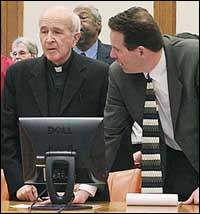 |
|
Rev. Gerald Robinson talks with attorney John Thebes as court opens today in Lucas County Common Pleas Court. Photo by The Blade/Allan Detrich |
After agreeing on 24 finalists, Judge Osowik and the legal teams for the defense and prosecution left the courtroom and met behind closed doors for about 45 minutes to make their selections.
Both the defense and prosecution were allowed up to four peremptory challenges with which they could eliminate prospective jurors without explanation. It could not be determined how many they were used.
Prospective jurors' religious backgrounds, affiliations, and beliefs were frequently questioned by Judge Thomas Osowik and attorneys during the selection process, that started Monday and ended yesterday.
Of the 16 who made the jury, eight have no religious affiliations, four are Catholics, two are United Methodists, one is Lutheran, and one is Baptist, based on courtroom interviews.
Any original material on these pages is copyright © BishopAccountability.org 2004. Reproduce freely with attribution.